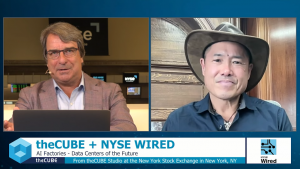 AI
AI
 AI
AI
 AI
AI
Unlike traditional linear computing, multidimensional computing operates across many dimensions simultaneously, unlocking native parallelism and far richer, more expressive data representations needed in artificial intelligence workloads.
Multidimensional computing is transforming AI factories, enabling them to tackle complex tasks with speed and efficiency. By surpassing traditional computing limits, it drives real-time adaptability, accelerates innovation and powers smarter AI solutions across industries, according to Bill Tai (pictured), chairman of the board of Hut8 Corp.

Hut8’s Bill Tai talks about how multidimensional computing underpins AI factories.
“What’s happening is that we’ve moved from a world where computing used to be kind of linear to computing is now multidimensional,” Tai said. “One of the reasons Nvidia is the center of the universe now is they got a very big head start processing what’s called matrix math … that is in effect what a GPU does. Now you’re going to have basically gigantic computation AI factories placed throughout this nation and the world where those connection points of telco lines connect and interconnect those brain elements into a giant pattern.”
Tai spoke with theCUBE’s John Furrier at theCUBE + NYSE Wired: AI Factories – Data Centers of the Future event, during an exclusive broadcast on theCUBE, SiliconANGLE Media’s livestreaming studio. They discussed how multidimensional computing underpins AI factories, enabling them to handle complex workloads and scale intelligence effectively.
AI factories transform multidimensional computing from theory into a scalable reality. This is attained through model parallelism, automated tuning and hardware optimization to accelerate innovation and redefine complex computation, according to Tai.
“These brains are getting larger and larger as people are able to now connect tens of thousands … of GPUs into one big cluster that then really does resemble something like a brain,” he said. “I think it’s leading to structural change in computing, structural change in the software and applications that can run on them and also insane amounts of power required to run all of this stuff. These AI factories are redefining computing.”
An AI factory is the convergence of massive data, computing power and advanced software, functioning like a synthetic brain. It processes streams of input — images, text, speech, sensors — much like human senses, enabling perception, reasoning, adaptation and creativity at industrial scale, Tai pointed out.
“It’s the integration of all of those things into something that looks like a gigantic neural fabric of computation elements with some very dense areas that might resemble parts of your brain that do certain things and other parts that are the interconnect between those dense parts and other dense parts that do other functions,” he said. “In the end, it’s going to resemble a little bit of what the internet backbone looks like. We’re going to see something that is just a vibrant fabric. We’re moving from a kind of a world of connected information to connected abstracted intelligence.”
Graphics processing units are essential to multidimensional computing, built for massive parallelism that powers high-dimensional data processing and complex model training. Unlike central processing units with a few sequential cores, GPUs pack thousands of smaller cores to run computations simultaneously — making them indispensable for AI and advanced data analysis, Tai emphasized.
“GPU, it’s a quick transformation of, relatively speaking, huge amounts of data,” he added. “I think because the architecture allowed multiple little points to be calculated all at once against many multiple other points, it became a much better architecture to kind of resemble the neural patterns of a brain where you have many neurons connected, interconnected by many synapses. GPUs, they’re performing incredible amounts of calculation at rates that are just thousands and thousands of times faster than a CPU could do.”
Here’s the complete video interview, part of SiliconANGLE’s and theCUBE’s coverage of theCUBE + NYSE Wired: AI Factories – Data Centers of the Future event:
Support our mission to keep content open and free by engaging with theCUBE community. Join theCUBE’s Alumni Trust Network, where technology leaders connect, share intelligence and create opportunities.
Founded by tech visionaries John Furrier and Dave Vellante, SiliconANGLE Media has built a dynamic ecosystem of industry-leading digital media brands that reach 15+ million elite tech professionals. Our new proprietary theCUBE AI Video Cloud is breaking ground in audience interaction, leveraging theCUBEai.com neural network to help technology companies make data-driven decisions and stay at the forefront of industry conversations.